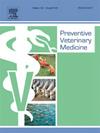Understanding drivers and barriers to stakeholder participation in syndromic surveillance for application in Australia
IF 2.2
2区 农林科学
Q1 VETERINARY SCIENCES
引用次数: 0
Abstract
Early detection of disease is crucial for an effective and timely disease control and eradication response and requires sensitive and robust surveillance systems. The use of early warning systems based on the systematic monitoring of health data and the identification of syndromes, known as syndromic surveillance systems, has been used for early identification of human and animal health events. Despite the marked development in animal health syndromic surveillance (AHSyS) systems in the last two decades, challenges for the implementation of functional AHSyS systems continue to exist, with limited research investigating stakeholder perspectives on these systems. The current project aimed to identify key drivers and barriers of livestock industry private sector stakeholder participation in syndromic surveillance in New South Wales (NSW), Australia. To achieve this aim, a qualitative study was conducted using semi-structured interviews with seven international syndromic surveillance experts and 17 private sector stakeholders, including abattoirs, knackeries, animal health consultants/veterinarians, research institutions, livestock industries, pharmaceutical companies, private veterinary laboratories and a national animal health body. The expert consultation identified that despite the significant advancements on AHSyS in the last two decades, implementation of AHSyS systems continue to be limited, with key considerations being the lack of data standardisation, issues with data privacy, data integration and the limited consideration of stakeholder needs for supporting decision-making and benefits from participation. Strong iterative collaboration with all stakeholders with high levels of trust, appropriate resourcing, and balance between regulatory and industry needs are required for supporting system sustainability. Animal health surveillance was important for all stakeholders in the consultation, however understanding of syndromic surveillance systems was limited. A significant amount of health and production data is already being collected by stakeholders; however, the data type and data collection platforms are highly variable, confirming the complexity for standardisation and integration. The major stakeholder concerns were in relation to privacy, protection of information and the potential commercial and/or trade implications of data misuse or misrepresentation, the required additional resourcing for participating and the regulatory nature of such system. Despite these concerns, all stakeholders showed interest in being involved in further discussions on the development of an AHSyS system. A successful AHSyS system should consider representativeness and quality of the data, simplicity in data collection and processing, clear benefits and value of the outputs, and strong collaboration across all relevant stakeholders. Outcomes from this project will inform future activities for the development of AHSyS initiatives in Australia.
了解驱动因素和障碍利益相关者参与综合征监测在澳大利亚的应用
早期发现疾病对于有效和及时的疾病控制和根除反应至关重要,需要敏感和强大的监测系统。利用基于对卫生数据的系统监测和综合征识别的早期预警系统,即综合征监测系统,已用于早期识别人类和动物卫生事件。尽管动物卫生综合征监测(AHSyS)系统在过去二十年中有了显著的发展,但实施功能性AHSyS系统的挑战仍然存在,调查利益相关者对这些系统的看法的研究有限。当前项目旨在确定澳大利亚新南威尔士州畜牧业私营部门利益相关者参与综合征监测的主要驱动因素和障碍。为实现这一目标,通过半结构化访谈,对7名国际综合征监测专家和17个私营部门利益攸关方进行了定性研究,包括屠宰场、糕点店、动物卫生顾问/兽医、研究机构、畜牧业、制药公司、私营兽医实验室和一个国家动物卫生机构。专家咨询认为,尽管AHSyS在过去二十年中取得了重大进展,但AHSyS系统的实施仍然受到限制,主要考虑因素是缺乏数据标准化、数据隐私问题、数据集成以及对利益相关者支持决策需求和参与利益的考虑有限。为了支持系统的可持续性,需要与所有利益相关者进行强有力的迭代合作,并具有高度的信任,适当的资源,以及监管和行业需求之间的平衡。动物卫生监测对磋商中的所有利益攸关方都很重要,但对综合征监测系统的了解有限。利益攸关方已经在收集大量卫生和生产数据;然而,数据类型和数据收集平台的变化很大,这证实了标准化和集成的复杂性。主要利益相关方关注的问题涉及隐私、信息保护以及数据滥用或失实陈述对商业和/或贸易的潜在影响、参与所需的额外资源以及此类系统的监管性质。尽管存在这些担忧,所有利益相关者都表示有兴趣参与AHSyS系统开发的进一步讨论。一个成功的AHSyS系统应该考虑数据的代表性和质量,数据收集和处理的简单性,产出的明确利益和价值,以及所有相关利益相关者之间的强有力合作。该项目的成果将为澳大利亚AHSyS倡议发展的未来活动提供信息。
本文章由计算机程序翻译,如有差异,请以英文原文为准。
求助全文
约1分钟内获得全文
求助全文
来源期刊

Preventive veterinary medicine
农林科学-兽医学
CiteScore
5.60
自引率
7.70%
发文量
184
审稿时长
3 months
期刊介绍:
Preventive Veterinary Medicine is one of the leading international resources for scientific reports on animal health programs and preventive veterinary medicine. The journal follows the guidelines for standardizing and strengthening the reporting of biomedical research which are available from the CONSORT, MOOSE, PRISMA, REFLECT, STARD, and STROBE statements. The journal focuses on:
Epidemiology of health events relevant to domestic and wild animals;
Economic impacts of epidemic and endemic animal and zoonotic diseases;
Latest methods and approaches in veterinary epidemiology;
Disease and infection control or eradication measures;
The "One Health" concept and the relationships between veterinary medicine, human health, animal-production systems, and the environment;
Development of new techniques in surveillance systems and diagnosis;
Evaluation and control of diseases in animal populations.
 求助内容:
求助内容: 应助结果提醒方式:
应助结果提醒方式:


